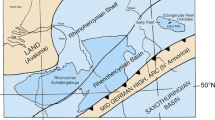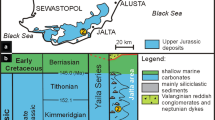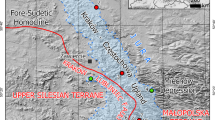Summary
The Middle Albian sequence from the western marginal area of the Vasco-Cantabrian Basin contains calcified microbialites in different marine depositional environments, individually well defined by microstructure, lamina characteristics and mode of formation. Microbialites may form the primary framework of reefs, which occur as composite stacks in mid to lower slope environments or as isolated bodies in small intraplatform basins. In most areas microbialite reef growth was initiated below the photic zone. Stratiform intercalations of microbialites and composite microbialite/foraminifer oncoids are restricted to well bedded carbonate platform deposits (Urgonian). Three basis types of microbialites are recognized:
-
(i)
Dense micritic/fenestral microbialites corresponding to laterally linked, stacked stromatolitic hemispheroids. The development and preservation of stromatolitic structure is a function of sediment supply and secondary obliteration by succesive boring activities. They were calcified in situ at the surface with irregularly curved linings of microcrystalline carbonate. Dense micritic/ fenestral microbialites, variously developed and preserved, are the main contributors to microbialite reefs. Microbialites form hard substrates bored by lithophagous pelecypods and boring sponges (Aka sp.). The main associated faunal elements include lithistid and coralline demosponges, hexactinellid sponges, encrusting foraminifera, brachiopods, polychaetes, and bryozoans.
-
(ii)
Dense micritic/peloidal microbialites with subplanar, arhythmic lamination (binding habit). They were calcified in situ below the surface in conjunction with decaying organic matter. At large scale, they occur in shallow water, i.e. within the photic zone. They cover earlier microbialite reefs or occur on and in episodic deposits of coarse biodebris. At small scale they occur in protected microenvironments (e.g. intraparticle space, boring cavities).
-
(iii)
Peloidal/in situ ooid microbialites with subplanar/ wavy lamination occur as small-scale stratiform intercalations in carbonate platform deposits, episodically revealing physical reworking. Other features are very similar to dense micritic/peloidal microbialites.
The results of geochemical analyses indicate a rock-buffered diagenetic system during early diagenetic and burial history of microbialite reefs. Independent of microbialite type residual MgCO3-contents are in the range of 1.20 to 3.57 mole %, agreeing well with those from isopachous rim cements and indicating a high Mg-calcite precursor of microbialite micrites. Stable isotope values (δ13C) are in the range of 3.13 to 3.80 (permil, vs PDB), close to the internal standard, the coralline spongeAcanthochaetetes (Albian species=2.93; Recent species=3.27) and comparable with inorganically precipitated Mg-calcite.
The temporal and spatial distribution of Albian in situ calcified microbialites reflects specific episodes and chemical environments with calcification, either at the surface, or below induced by self burial effects. Positive shifts in alkalinity and [Ca2+] triggered off by the net effect of continental drainage, injection of diapir-derived brines, and paleokarst developments are discussed as the main driving force for the generation of in situ calcified microbialites.
Similar content being viewed by others
References
Aitken, J.D. (1967): Classification and environmental significance of cryptalgal limestones and dolomites, with illustrations from the Cambrian and Ordovician of southwestern Alberta.—J. Sed. Petrol.37, 1163–1178, Tulsa
Awramik, S.M. (1976): Gunflint stromatolites: microfossil distribution in relation to stromatolite morphology.—In:Walter, M.R. (ed.): Stromatolites.—Dev. Sed.,20, 311–320, Amsterdam (Elsevier)
Bates, R.L. &Jackson, J.A. (1987): Glossary of Geology.—788 p., Alexandria (AGI)
Bathurst, R.G.C. (1975): Carbonate sediments and their diagenesis. —Dev. Sed.,12, 658 p. Amsterdam (Elsevier)
Berner, R.A. (1980): Early diagnesis. A theoretical approach.— 237 p., Princton (Princton, Univ. Press)
Borowitzka, M.A. (1989): Carbonate Calcification in Algae-Initiation and Control.—In:Mann, W., Webb, J. &Williams, R.J.P. (eds.): Biomineralization.—Chemical and Biochemical Perspectives.—63–94, Weinheim (VCH Verlagsges.)
Burne, R.V. &Moore, L.S. (1987): Microbialites: Organosedimentary Deposits of Benthic microbial communities.— Palaios,2, 241–254, Tulsa
Castanier, S., Maurin, A. &Perthuisot, J.-P. (1989): Production bactérienne expérimentale de corpuscules carbonatés, sphéroidaux à structure fibro-radiaire. Réflexions sur la définition des ooides.—Bull. Soc. géol. Fr.,1989/3, 589–595, Paris
Chafetz, H.S. (1986): Marine peloids: a product of bacterially induced precipitation of calcite.—J. Sed. Petrol.,56/6, 812–817, Tulsa
Chafetz, H.S. &Buczinski, C. (1992): Bacterially Induced Lithification of Microbial Mats.—Palaios,7, 277–293, Tulsa
Chester, R. (1990): Marine Geochemistry.—698 p., London (Unwin Hyman)
Degens, E.T. &Ittekot, V. (1986): Ca2+-stress, biological response and particle aggregation in the aquatic habitat.— Netherlands J. Sea Res.,20/2–3, 109–116;
Degens, E.T., Kazmierczak, J. &Ittekot, V. (1986): Biomineralization and the Carbon Isotope Record.—Tschermaks Min. Petr. Mitt.,35, 117–126, Berlin
Fernandez-Mendiola, P.A. &Garcia-Mondejar, J. (1991): Depositional history of Aptian-Albian carbonate platforms: Aitzgorri Massif, northern Spain.—Cret. Res.,12, 293–320, London
Garcia-Mondejar, J. (1979): Successions paléogéographiques du complexe urgonien dans le SW de la région Basco-Cantabrique (Nord de l’Espagne).—Géobios, Mém. spec.,3, 71–78, Lyon
Garcia-Mondejar, J. (1985): Carbonate platform-basin transition in the Soba reef area (Aptian-Albian of western Basque-Cantabrian region, Northern Spain.—6th regional meeting I.A.S. Lleida, 172–175, Lleida
— (1990): The Aptian-Albian carbonate episode of the Basque-Cantabrian Basin (northern Spain): general characteristics, controls and evolution.—In:Tucker, M.E. (ed.): Carbonate platforms: facies, sequences and evolution.—Spec. Publs int. Ass. Sediment.,9, 257–290, Oxford (Blackwell)
— (1991): Strike-Slip Subsidence of the Basque-Cantabrian Basin of Northern Spain and Its Relationship to Aptian-Albian Opening of Bay of Biscay.—Amer. Ass. Petrol. Geol. Mem.,46, 395–409, Tulsa
Garcia-Mondejar, J. &Fernandez-Mendiola, P.A. (1993): Sequence Stratigraphy and Systems Tracts of a Mixed Carbonate and Siliciclastic Platform-Basin Setting: The Albian of Lunada and Soba, Northern Spain.—Amer. Ass. Petrol. Geol. Bull.,77/2, 245–275, Tulsa
Garcia-Mondejar, J., Hines, F.M., Pujalte, V. & Reading, H.G. (1985): Sedimentation and tectonics in the western Basque-Cantabrian area (Northern Spain) during Cretaceous and Tertiary times.—6th regional meeting I.A.S. Lleida, excursion guide, 307–392, Lleida
Garcia-Mondejar, J. &Pascal, A. (1978): Précisions stratigraphiques et sédimentologiques sur les terminaisons calcaires sud-occidentales du système urgonien basco-cantabrique (Espagne du Nord).—Bull. Soc. géol. Fr.,XX/2, 179–183, Paris
Gerdes, G. &Krumbein, W.E. (1987): Biolaminated deposits.— Lect. Notes Earth Sciences,9, 183 p., Berlin (Springer)
Hopkins, J.C. (1977): Production of foreslope breccia by differential submarine cementation and downslope displacement of carbonate sands, Miette and Ancient Wall Buildups, Devonian, Canada.—In:Cook, H.E. & Enos, P. (eds.): Deep-Water Carbonate Environments.—Soc. Econ. Paleont. Min. Spec. Publ,25, 155–177, Tulsa
Kade, N. (1991): Mikrofazielle und Palökologische Entwicklung flachmariner Karbonate am Westrand des Basko-Kantabrischen Kreidebeckens während des Aptium (Provinz Santander, Spanien).—Diplom-thesis, FB Geowiss. FU Berlin, 77 p., (unpublished)
Kazmierczak, J., Ittekot, V. &Degens, E.T. (1985): Biocalcification through time: environmental challenge and cellular response.—Paläont. Z.,59, 15–33, Stuttgart
Kempe, S. &Kazmierczak, J. (1990): Calcium Carbonate Supersaturation and the formation of in situ Calcified Stromatolites. —In:Ittekot, V., Kempe, S., Michaelis, W. &Spitzy, A. (eds.): Facets of Modern Biogeochemistry.—255–278, Berlin (Springer)
Kempe, S. &Kazmierczak, J. &Degens, E.T. (1989): The soda ocean concept and its bearing on biotic evolution.—In:Crick, R.E. (ed.): Origin, Evolution, and Moderns Aspects of Biomineralization in Plants and Animals.—29–43, New York (Plenum Press)
Kenter, J.A.M. (1990): Carbonate platform flanks: slope angle and sediment fabric.—Sedimentology,37, 777–794, Oxford
Keupp, H., Jenisch, A., Herrmann, R., Neuweiler, F. & Reitner, J. (1993): Modern cryptic microbial carbonate crusts: a key for the environmental analysis of fossil spongiolites?-(this volume)
Klement, K.W. (1967): Practical classification of reefs and banks, bioherms and biostromes.—Amer. Ass. Petrol. Geol. Bull.,51, 167–168, Tulsa
Koch, T. (1990): Fazies-Entwicklung und Diagenese eines Mud Mound aus dem mittleren Alb des Basko-Kantabrischen Beckens (La Gandara, Nordspanien).—Diplom-thesis, FB Geowissenschaftender FU Berlin, 102 p., (unpublished)
Koch, T. &Reitner, J. (1989): Aufbau und Genese eines Slope mud Mound aus dem Mittelalb von La Gandara (Nord-spanien).— Berliner geowiss. Abh. (A)106, 243–265, Berlin
Krumbein, W.E. (1979): Photolithotrophic and chemoorganotrophic activity of bacteria and algae as related to beachrock formation and degradation, (Gulf of Aqaba, Sinai).— Geomicrobiol. J.,1, 139–203, New York
— (1983): Stromatolites.—the challenge of a term in space and time.—Precambrian Res.,20, 493–531, Amsterdam
— (1986): Biotransfer of minerals by microbes and microbial mats.—In:Leadbeater, B.S.C. &Riding, R. (eds.): Biomineralization in Lower Plants and Animals.—Systematics Assoc., Spec. Vol.30, 55–72, Oxford (Clarendon press)
Lees, A. (1988): Waulsortian “reefs”: the history of a concept.— Mém. Inst. géol. Univ. Louvain,34, 43–55, Louvain
Lohmann, K.C. (1988): Geochemical patterns of meteoric diagenetic systems and their application to paleokarts.—InChoquette, P.W. &James, N.P. (eds.): Paleokarst.—58–80, New York (Springer)
Lowenstam, H.A. (1981): Minerals formed by organisms.— Science,211, 1126–1131, Washington
McConnaughey, T. (1989):13C and18O isotopic disequilibrium in biological carbonates: II. In vitro simulation of kinetic isotope effects.—Geochem. Cosmochem. Acta,53, 163–171, London
Monty, C. (1976): The origin and development of cryptalgal fabrics.—In:Walter, M.R. (ed.): Stromatolites.—Dev. Sed.,20, 193–249, amsterdam (Elsevier)
Monty, C. (1984): Mud-Mounds: Geology and Palaeoecology.—In:Geister, J. & Herb, R. (eds.): Géologie et Paleoécologie des récifs.—3ème Cycle Romand en Science de la Terre, 23.1–23.8, Bern
Morse, J.W. &Mackenzie, F.T. (1990): Geochemistry of Sedimentary Carbonates.—Dev. Sed.,48, 707 p., Amsterdam (Elsevier)
Neuweiler, F. (1992a): Mud Mounds und Reef Mounds aus der Unterkreide (Alb) Nordspaniens: Fazies, Paläobathymetrie und Diagenese.—Meeting: Sediment’92, Berlin (abstract)
Neuweiler, F. (1992b): Mud Mounds (L. Cretaceous, N. Spain): Control by structural differentiation, paleokarst development and brine flux.—13th regional meeting I.A.S. Jena (abstract)
Neuweiler, F. (in prep.): Dynamische Sedimentationsvorgänge, Diagenese und Biofazies an einem unterkretazischen Plattformrand; Alb, Soba region, Cantabria, Nordspanien.—Diss. FB Geowissenschaften der FU Berlin
Neuweiler, F. &Reitner, J. (1992): Karbonatbänke mitLithocodium aggregatum Elliott/Bacinella irregularis Radoicic. Paläobathymetrie, Paläoökologie und stratigraphisches Äquivalent zu thrombolithischen Mud Mounds.—Berliner geowiss. Abh (E),3, 273–293, Berlin
Nultsch, W. (1986): Allgemeine Botanik.—530 p., Stuttgart (Thieme)
Park, R.K. (1977): The preservation potential of some recent stromatolites.—Sedimentology,24, 485–506, Oxford
Pascal, A. (1983): L’Urgonien-systèmes biosédimentaires et tectonogenèse.—Mém. géol. Univ. Dijon,9, 45–72, Dijon
Pascal, A. (1985): Les systèmes biosédimentaires urgoniens (Aptien-Albien) sur la marge Nord Ibérique.—Mém. géol. Univ. Dijon,10, 569 p., Dijon
Pascal, A. &Przybyla, A. (1989): Processus biosédimentaire et diagénétiques précoces dans les mud-mounds (Thrombolitemounds) urgonniens d’Espagne du Nord.—Géol. Mediterran.,16, 171–183, Marseille
Pentecost, A. &Riding, R. (1986): Calcificationin cyanobacteria..—InLeadbeater, B.S.C. &Riding, R. (eds.): Biomineralization in Lower Plants and Animals.—Systematics Assoc., Spec. Vol.,30, 73–90, Oxford (Clarendon press)
Rat, P. (1959): Les Pays crétacés basco-cantabrique.—Publ. Univ. Dijon,XVIII, 525 p., Dijon
Rat, P., Amiot, M., Feuillée, P., Floquet, M., Mathey, B., Pascal, A. &Salomon, J. (1982): Étapes et style de l’évolution de la marge cantabrique et de son arrière-pays (Espagne) au Crétacé.—C.R. Acad. Sci.,295, 247–250, Paris
Reid, R.P. (1987): Nonskeletal peloidal precipitates in Upper Triassic reefs, Yukon Territory (Canada).—J. Sed. Petrol.,57/5, 893–900, Tulsa
Reitner, J. (1982): Die Entwicklung von Inselplattformen und Diapir-Atollen im Alb des Basko-Kantabrikums (Nordspanien)..—N. Jb. Geol. Paläont.,165/1, 87–101, Stuttgart
— (1986): A Comparative Study of the Diagenesis in Diapir-Influenced Reef Atolls and a Fault Block Reef Platform in the Late Albian of the Vasco-Cantabrian Basin (Northern Spain). —InSchroeder, J.H. &Purser, B.H. (eds.): Reef Diagenesis. —186–209, Berlin (Springer)
Reitner, J. (1987): Mikrofazielle, palökologische und paläogeographische Analyse ausgewähler Vorkommen flachmariner Karbonate im Basko-Kantabrischen Strike Slip Fault-Becken-System (Nordspanien) an der Wende von der Unterkreide zur Oberkreide.— Documenta naturae,40, 239 p., Munich
— (1989): Lower and Mid-Cretaceous Coralline sponge Communities of the Boreal and Tethyan Realms in Comparison with the Modern Ones.—In:Wiedmann, J. (ed.): Cretaceous of the Western Tethys.—Proc. 3rd Internat. Cretaceous Symp., Tübingen: 851–878, Stuttgart (Schweizerbart)
Reitner, J. (1992): “Coralline Spongien”.—Der Versuch einer phylogenetisch-taxonomischen Analyse.—Berliner geowiss. Abh. (E),1, 352 p., Berlin
Reitner, J. (1993): Modern cryptic microbialite/metazoan-facies from Lizard Island (Great Barrier Reef, Australia)-Formation and concepts.—(this volume)
Reitner, J. &Engeser, T. (1983): Contributions to the systematics and the palaeoecology of the family Acanthochaetetidae (Fischer 1970) Order Tabulospongida, Class Sclerospongiae..—Geobios,16, 773–779, Lyon
— &-— (1987): Skeletal structures and habitates of Recent and fossilAcanthochaetetes (subclass Tetractinomorpha, Demospongiae, Porifera).—Coral Reefs,6, 151–157, Berlin
Reitner, J. &Keupp, H. (1991): The Fossil Record of the Haplosclerid Excavating SpongeAka de Laubenfels.—In:Reitner, J. &Keupp, H. (eds.): Proc. Fossil & Recent Sponges..—102–120, Berlin (Springer)
Riding, R. (1991): Classification of Microbial Carbonates.—In:Riding, R. (ed.): Calcareous Algae and Stromatolites.—21–51, Berlin (Springer)
Sarg, J.F. (1988): Carbonate sequence stratigraphy.—In:Wilgus, C.K., Hastings, B.S., Kendall, C.G.St.C., Posamentier, H.W., Ross, C. & Van Wagoner, J.C. (eds.): Sea-Level Changes: An Integrated Approach.—Soc. Econ. Paleont. Min. Spec. Publ.,42, 155–181, Tulsa
Scott, R.W., Frost, S.H. & Shaffer, B.L. (1988): Early Cretaceous sea-level curves, Gulf Coast and southeastern Arabia. —In:Wilgus, C.K., Hastings, B.S., Kendall, C.G.St.C., Posamentier, H.W., Ross, C. & Van Wagoner, J.C. (eds.): Sea-Level Changes: An Integrated Approach.—Soc. Econ. Paleont. Min. Spec. Publ.,42, 275–284, Tulsa
Semikhatow, M.A., Gebelein, C.D., Cloud, P., Awramik, S.M. &Benmore, W.C. (1979): Stromatolite morphogenesis-progress and problems.—Can. J. Earth Sci.,16, 992–1015, Ottawa
Simkiss, K. (1977): Biomineralization and Detoxification.— Calcif. Tiss. Res.,24, 199–200, Berlin
Stryer, L. (1991): Biochemie, 1127 p., Heidelberg (Spektrum)
Tsien, H.H. (1985): Algal-bacterial origin of micrites in mud mounds.—In:Toomey, D.F. &Nitecki, M.H. (eds.): Paleoalgology..—290–296, Berlin (Springer)
Author information
Authors and Affiliations
Rights and permissions
About this article
Cite this article
Neuweiler, F. Development of albian microbialites and microbialite reefs at marginal platform areas of the Vasco-Cantabrian Basin (Soba reef area, Cantabria, N. Spain). Facies 29, 231–249 (1993). https://doi.org/10.1007/BF02536930
Received:
Accepted:
Issue Date:
DOI: https://doi.org/10.1007/BF02536930




